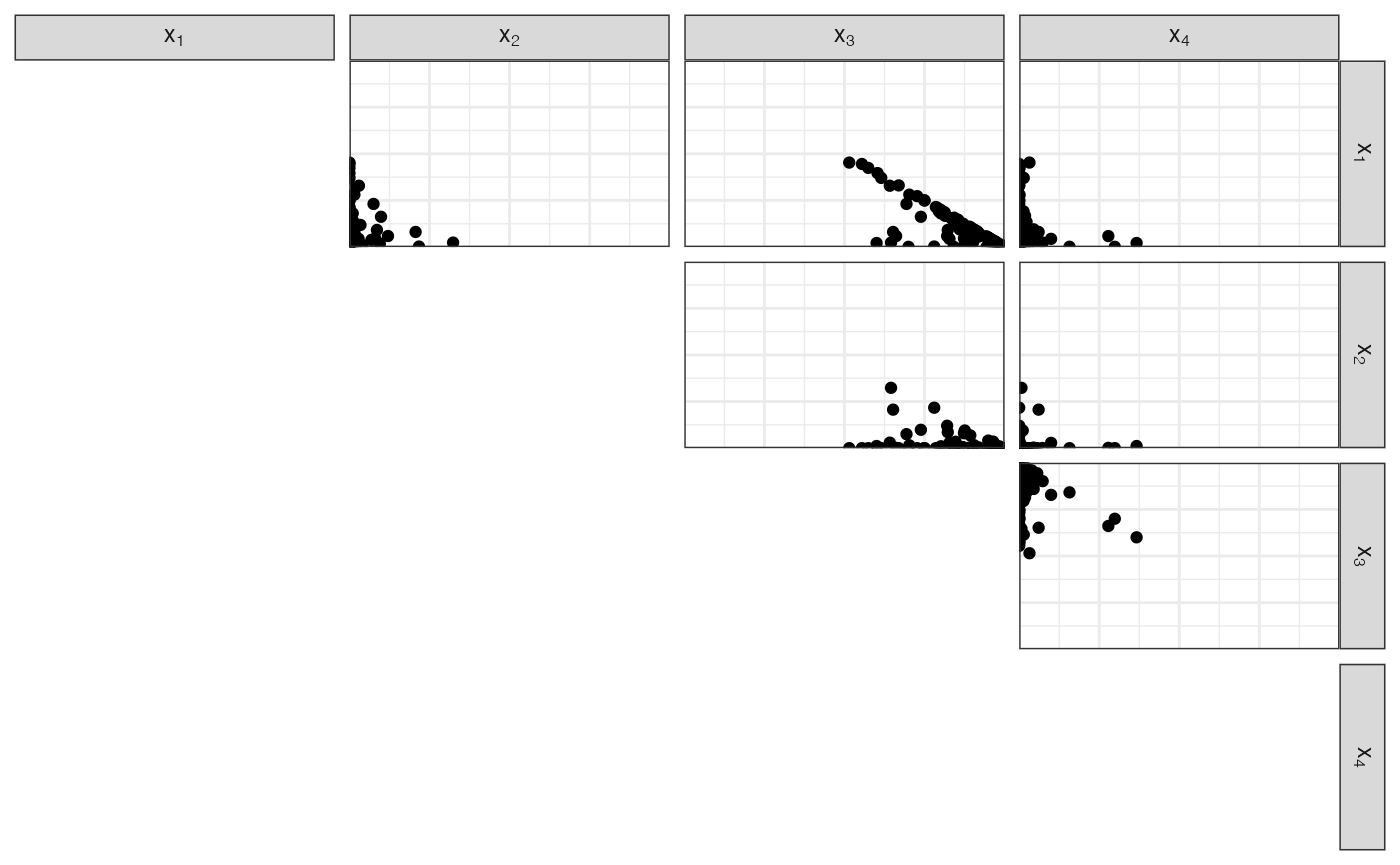Dirichlet distribution tools
Lorenzo Gaborini
2021-03-05
Source:vignettes/dirichlet-distribution.Rmd
dirichlet-distribution.RmdThis package contains functions to sample from a Dirichlet distribution.
Notation
We call \(\text{Simplex}{(p-1)}\) the set of vectors in \(\mathbb{R}^p\) whose components form a distribution on \(p\) items.
In other words, \(\boldsymbol{X} \in \text{Simplex}{(p-1)}\) iff \(X_i \in [0,1]\) and \(\sum_{i=1}^p X_i = 1\).
Let \(\boldsymbol{X}\) be a vector in \(\text{Simplex}{(p-1)}\), let \(\boldsymbol{\alpha}\) be a vector in \(\mathbb{R}^p\) with positive components.
Then, \(X\) can have the Dirichlet distribution: \(X \mid \boldsymbol{\alpha} \sim \text{Dirichlet}{(\boldsymbol{\alpha})}\).
We can write \(\boldsymbol{\alpha} = \alpha_0 \, \boldsymbol{\nu}\), where:
- \(\alpha_0 = \sum_i \alpha_i\) is the concentration parameter: \(\alpha_0 \in \mathbb{R}^{+}\)
- \(\boldsymbol{\nu}\) is the base measure: \(\boldsymbol{\nu} \in \text{Simplex}{(p-1)}\).
Properties
- \(\mathop{\mathbb{E}}[\boldsymbol{X}] = \boldsymbol{\alpha} / \alpha_0 = \boldsymbol{\nu}\)
- \(\mathop{\mathrm{Var}}[\boldsymbol{X}] = \dfrac{ \boldsymbol{\nu} \cdot (1 - \boldsymbol{\nu})}{\alpha_0 + 1}\)
Particular cases
If \(\boldsymbol{\nu}\) is constant, \(\boldsymbol{\nu} = 1/p\). The Dirichlet distribution is called symmetric Dirichlet, and is only parametrised by the concentration parameter \(\alpha_0\).
- When \(\alpha_0 = p\), \(\alpha_i = 1 \forall i\): the Dirichlet distribution is uniform over \(\text{Simplex}{(p-1)}\). This is the least informative situation.
- When \(\alpha_0 \to 0\), \(\alpha_i \to 0\): the Dirichlet distribution concentrates over the border of \(\text{Simplex}{(p-1)}\).
- When \(\alpha_0 \gg 1\), \(\alpha_i \to 0\): the Dirichlet distribution concentrates over the mean (and the variance decreases).
Examples
Sample from a \(p=4\) Dirichlet:
n <- 100
# The parameter
alpha <- c(0.5, 0.1, 5, 0.1)
p <- length(alpha)
# Concentration and base measure
alpha0 <- sum(alpha)
nu <- alpha / alpha0\(\alpha_0 = 5.7\)
\(\boldsymbol{\nu} = \left( 0.0877193, 0.0175439, 0.877193, 0.0175439 \right)\)
\(\boldsymbol{\alpha} = \left( 0.5, 0.1, 5, 0.1 \right)\)
df_diri <- fun_rdirichlet(n, alpha)
head(df_diri)
#> # A tibble: 6 x 4
#> `x[1]` `x[2]` `x[3]` `x[4]`
#> <dbl> <dbl> <dbl> <dbl>
#> 1 0.0243 9.74e- 4 0.901 7.33e- 2
#> 2 0.0465 4.45e- 7 0.902 5.17e- 2
#> 3 0.0625 3.00e- 3 0.890 4.47e- 2
#> 4 0.158 1.07e- 4 0.842 4.17e- 7
#> 5 0.000115 5.70e-20 1.00 1.10e-19
#> 6 0.397 1.44e- 6 0.603 8.62e-11#> Loading required namespace: GGally
#> Registered S3 method overwritten by 'GGally':
#> method from
#> +.gg ggplot2
Uniform sampling
Uniform base measure, unitary Dirichlet parameters: \(\boldsymbol{\alpha} = \boldsymbol{1}\).
nu <- rep(1, p)/p
alpha0 <- p
alpha <- nu * alpha0\(\alpha_0 = 4\)
\(\boldsymbol{\nu} = \left( 0.25, 0.25, 0.25, 0.25 \right)\)
\(\boldsymbol{\alpha} = \left( 1, 1, 1, 1 \right)\)
df_diri <- fun_rdirichlet(n, alpha)
head(df_diri)
#> # A tibble: 6 x 4
#> `x[1]` `x[2]` `x[3]` `x[4]`
#> <dbl> <dbl> <dbl> <dbl>
#> 1 0.0269 0.289 0.529 0.155
#> 2 0.117 0.0997 0.158 0.625
#> 3 0.302 0.372 0.133 0.194
#> 4 0.549 0.260 0.0809 0.110
#> 5 0.139 0.493 0.0720 0.297
#> 6 0.223 0.244 0.485 0.0483
scatter_matrix_simplex(df_diri)
Concentrated sampling
Concentration parameter \(\gg p\), Dirichlet parameters \(\gg 1\)
nu <- rep(1, p)/p
alpha0 <- 100
alpha <- nu * alpha0\(\alpha_0 = 100\)
\(\boldsymbol{\nu} = \left( 0.25, 0.25, 0.25, 0.25 \right)\)
\(\boldsymbol{\alpha} = \left( 25, 25, 25, 25 \right)\)
df_diri <- fun_rdirichlet(n, alpha)
head(df_diri)
#> # A tibble: 6 x 4
#> `x[1]` `x[2]` `x[3]` `x[4]`
#> <dbl> <dbl> <dbl> <dbl>
#> 1 0.257 0.294 0.211 0.239
#> 2 0.202 0.326 0.202 0.269
#> 3 0.199 0.263 0.253 0.284
#> 4 0.241 0.268 0.299 0.192
#> 5 0.281 0.257 0.202 0.259
#> 6 0.220 0.221 0.255 0.304
scatter_matrix_simplex(df_diri)
Degenerate sampling
Concentration parameter \(\\ p\), Dirichlet parameters \(\\ 1\)
nu <- rep(1, p)/p
alpha0 <- 0.01
alpha <- nu * alpha0\(\alpha_0 = 0.01\)
\(\boldsymbol{\nu} = \left( 0.25, 0.25, 0.25, 0.25 \right)\)
\(\boldsymbol{\alpha} = \left( 0.0025, 0.0025, 0.0025, 0.0025 \right)\)
df_diri <- fun_rdirichlet(n, alpha)
head(df_diri)
#> # A tibble: 6 x 4
#> `x[1]` `x[2]` `x[3]` `x[4]`
#> <dbl> <dbl> <dbl> <dbl>
#> 1 3.32e- 8 1.00e+ 0 5.17e-53 1.92e-139
#> 2 5.03e- 79 6.23e- 46 1.00e+ 0 0.
#> 3 1.00e+ 0 3.22e- 16 3.92e-14 1.41e-154
#> 4 8.03e- 15 9.67e-109 1.00e+ 0 3.43e- 61
#> 5 1.00e+ 0 5.86e-103 0. 3.09e- 81
#> 6 1.25e-235 1.18e-182 1.00e+ 0 5.86e-206
scatter_matrix_simplex(df_diri)